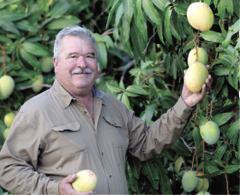From the Fields - Rod Chamberlain

Photo/Melissa Jewel
By Rod Chamberlain, Riverside County tomato and mango farmer
In the Coachella Valley, we seed tomatoes in September, October, and then we transplant in October, November. We start harvesting in February and March. This year, we were hit hard with all the price increases. Our fertilizer costs basically tripled. We had to make some decisions: We cut back our acreage a little bit and focused on our more popular items, the cherry tomatoes in particular.
The season worked out pretty well for us. We were able to cut our expenses and our initial investment costs and still come out with the crop. It wasn’t a bumper crop obviously with the cutbacks, but we were able to maintain our profitability. With fuel and transportation costs, we had to cut back on some of our smaller (farmers) markets that had a little higher overhead to supply. We basically maintained our profitability doing that. There’s a limit to how much of the cost you can pass on to the consumers.
On the mangos, we started picking the end of July. We’re four weeks late on the start of our season. I don’t remember it starting this late. I think that’s all due to the cool winter. It wasn’t cold necessarily. It’s not like we had a lot of freezing weather, but it was definitely cool, so we didn’t have the fruit development. Normally, we’ll get days in the 70s and 80s during late winter. But in February and March, we didn’t get anything at all; we were down in the 60s almost the whole time. This is the end of our second week at the markets, so everything is running super late. But the fruit looks good. The crop looks good. It looks like an average to better-than-average crop.




